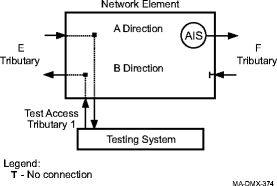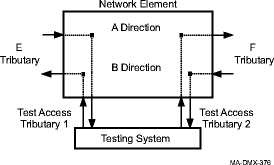Procedure 14-23: Establish external test access session in the SPLT(E or EF) mode
 Overview
Overview
Use this procedure to establish a new external test access session in the following test access modes:
To establish an internal test access session in the SPLT(A or E) mode, refer to Procedure 14-31: Establish internal test access session in the SPLT(A or E) mode.
Important!
Initially, an external test access session must be established in the MONE or MONEF test access mode and then changed:
Important!
The Tributary Maintenance parameter for the affected connected tributaries must be provisioned Allow to perform this procedure. If the Tributary Maintenance parameter for the affected connected tributaries is provisioned to Inhibit, test access commands for the affected ports are denied. Unconnected tributaries are always available for SPLTE test access.
To view the Tributary Maintenance parameter, a Privileged, General, Maintenance, or Reports Only user must select Administration → Allow/Inhibit Tributary Maintenance to access the required tributary.
To provision the Tributary Maintenance parameter, a Privileged user must perform Procedure 7-23: Allow/inhibit port/tributary maintenance.
 Privilege level
Privilege level
You must log in as either a Privileged, General, or Maintenance user to complete this procedure.
SPLTE mode
The SPLTE mode is used to test the E Tributary signal.
The following figure shows an example of the SPLTE mode used to test the E Tributary signal of a two-way cross-connection.

The E Tributary signal is split from the F Tributary signal. AIS is transmitted on the outgoing F Tributary signal and the incoming F Tributary signal is terminated. If there is a one-way cross-connection from the E Tributary to F Tributary, AIS is transmitted on the outgoing F Tributary signal. The E Tributary can also be idle (no cross-connection). The E Tributary or F Tributary cannot be on an Ethernet circuit pack.
SPLTEF mode
The SPLTEF mode is used to test the E Tributary signal and F Tributary signal.
The following figure shows an example of the SPLTEF mode used to test the E Tributary signal and F Tributary signal of a two-way cross-connection.

Two test access tributaries are required. If the E Tributary is part of a two-way cross-connection, entering the F Tributary is optional. The SPLTEF mode is not supported for tributaries that have one-way cross-connections or idle tributaries (no cross-connections). The E Tributary or F Tributary cannot be on an Ethernet circuit pack.
Supported VT1.5 rate test access configurations
The following table shows the E Tributaries and F Tributaries (VT1.5 cross-connections) and the supported Test Access Tributaries.
|
Test Access Tributaries | ||||||||
|---|---|---|---|---|---|---|---|---|
|
A Slot |
D-G Slots |
D-G Slots1 - 1+1 Only2 | ||||||
|
DS1 |
EC1 |
TMUX |
DS1/E1 |
OC-3/12/48 | ||||
|
LNW39 LNW112 |
LNW16 LNW19 LNW19B LNW207 |
LNW18 LNW207 |
LNW6 LNW7 LNW8 |
LNW31 LNW36 LNW37 LNW45 LNW46 LNW49 LNW62 | ||||
|
E Tributary and F Tributary3 |
Main Add/Drop VT1.5 Cross-Connection to: 5, 6 |
FN A-G |
DS3/EC14 |
✓ |
✓ |
✓ |
✓ |
✓ |
|
FN D-G |
TMUX8 |
✓ |
✓ |
✓ |
✓ |
✓ | ||
|
OC-3/12/48 |
✓ |
✓ |
✓ |
✓ |
✓ | |||
|
E Tributary and F Tributary3 |
DS1/EC1 (FN A-G) VT1.5 Hairpin Cross-Connection to: 5, 6 |
FN D-G |
DS3/EC14 |
✓ |
✓ |
✓ |
✓ |
✓ |
|
TMUX8 |
✓ |
✓ |
✓ |
✓ |
✓ | |||
|
OC-3/12/48 |
✓ |
✓ |
✓ |
✓ |
✓ | |||
|
OC-3/12/48 (FN D-G) VT1.5 Hairpin Cross-Connection to: 5, 6 |
FN D-G |
DS3/EC14 |
✓ |
✓ |
✓ |
✓ |
✓ | |
|
TMUX8 |
✓ |
✓ |
✓ |
✓ |
✓ | |||
|
OC-3/12/48 |
✓ |
✓ |
✓ |
✓ |
✓ | |||
|
1 Test Access Tributary 1 and Test Access Tributary 2 are always connected to the same optical interface. 2 Intended for 1+1 interfaces (port Application parameter = 1+1) to locally-connected testheads only. 3 Main OLIUs with large VT switch fabric or Very Large Fabric (VLF) only. Restrictions apply to the OC-3/OC-12 OLIU circuit packs. 4 EC-1 interfaces only. 5 Test Access of locked cross-connections restricted to electrical test access tributaries. 6 Test Access of UPSR Dual Ring Interworking and UPSR pass-through cross-connections is not supported. 7 LNW20 48TMUXDS3EC1 Ported only. 8 LNW20 48TMUXDS3EC1 Ported or Portless. | ||||||||
Supported STS-1 rate test access configurations
The following table shows the E Tributaries and F Tributaries (STS-1 rate cross-connections) and the supported Test Access Tributaries.
|
Test Access Tributaries | ||||||
|---|---|---|---|---|---|---|
|
B Slot |
D-G Slots |
D-G Slots1 - 1+1 Only2 | ||||
|
DS3 |
DS3/EC1 |
OC-3/12/48 | ||||
|
LNW39 LNW111 |
LNW16 LNW19 LNW19B LNW205 |
LNW31 LNW36 LNW37 LNW45 LNW46 LNW49 LNW62 | ||||
|
E Tributary and F Tributary |
Main Add/Drop STS-1 Cross-Connection to: 3, 4 |
FN B-G |
DS3/EC1 |
✓ |
✓ |
✓ |
|
FN D-G |
TMUX6 |
✓ |
✓ |
✓ | ||
|
OC-3/12/48 |
✓ |
✓ |
✓ | |||
|
Thru STS-1 Cross-Connection |
✓ |
✓ |
✓ | |||
|
E Tributary and F Tributary |
DS3/EC-1 (FN B-G) STS-1 Hairpin Cross-Connection to: 3, 4 |
FN D-G |
DS3/EC1 |
✓ |
✓ |
✓ |
|
TMUX6 |
✓ |
✓ |
✓ | |||
|
OC-3/12/48 |
✓ |
✓ |
✓ | |||
|
OC-3/12/48 (FN D-G) STS-1 Hairpin Cross-Connection to: 3, 4 |
FN B-G |
DS3/EC1 |
✓ |
✓ |
✓ | |
|
FN D-G |
TMUX6 |
✓ |
✓ |
✓ | ||
|
OC-3/12/48 |
✓ |
✓ |
✓ | |||
|
1 Test Access Tributary 1 and Test Access Tributary 2 are always connected to the same optical interface. 2 Intended for 1+1 interfaces (port Application parameter = 1+1) to locally-connected testheads only. 3 Test Access of locked cross-connections restricted to electrical test access tributaries. 4 Test Access of UPSR Dual Ring Interworking cross-connections is not supported. 5 LNW20 48TMUXDS3EC1 Ported only. 6 LNW20 48TMUXDS3EC1 Ported or Portless. | ||||||
Restrictions
The following restrictions apply when establishing an external test access session in the SPLT(E or EF) mode.
-
A new external test access session must be created only in the MONE or MONEF test access mode initially and then changed from MONE to SPLTE, or from MONEF to SPLTEF.
-
A new test access session is denied if a node or ring network upgrade is active (node is in provisioned Ring Upgrade mode).
-
A new test access session is denied if a transmission test, loopback, or test access session is already active on an affected port.
-
If the Main slots are equipped with LNW40/LNW302/LNW601 OC-3 or LNW38/LNW51/LNW382 OC-12 OLIU circuit packs, the VT1.5 test access cross-connection capacity is limited because of the small VT switch fabric. Therefore, it is recommended that you use only the MONE or SPLTE mode and avoid using ports on the LNW6, LNW7, LNW39, LNW111, and LNW112 circuit packs for the E Tributary, F Tributary, and Test Access Tributaries.
-
If the E Tributary or F tributary is part of a locked DSn cross-connection, the Test Access Tributary connected to the optical side of the locked DSn cross-connection must be an idle tributary of an electrical interface with a matching rate.
-
Test Access of UPSR Dual Ring Interworking cross-connections is not supported.
-
Test Access of VT1.5 through cross-connections (UPSR) is not supported.
|
NOTICE Service-disruption hazard |
Service interruptions can occur on tributaries if they are accidentally tested. Service interruptions may also occur on unintended tributaries if unsupported test access configurations are attempted.
Recheck the address (AID) of the tributary(ies) being tested and the test access tributary(ies). Do not attempt to establish unsupported test access sessions.
 Before you begin
Before you begin
Prior to performing this procedure:
-
Refer to Before you begin and Required equipment in this chapter.
-
Refer to Laser safety and Electrostatic discharge in Chapter 1, Safety.
-
Verify that the work instructions identify the test access mode, test access rate, and the assigned addresses (AIDs) of the tributary(ies) to be tested and the test access tributary(ies).
-
If the work instructions specify optical test access tributaries are to be used, verify that 1+1 optical interfaces to locally-connected testheads exist. If required, refer to Procedure 9-9: Establish low-speed 1+1 unprotected optical linear extension to establish a 1+1 interface to the local testhead.
Steps
Complete the following steps to establish a new external test access session in the SPLT(E or EF) mode.
1 |
Important! Initially, an external test access session must be established in the MONE or MONEF test access mode and then changed from MONE to SPLTE or from MONEF to SPLTEF. Establish the required external test access session in the MONE or MONEF test access mode.
Reference: Procedure 14-22: Establish external test access session in the MON(E or EF) mode | ||||||
2 |
Change the test access mode of the test access session established in the previous step as required from: Reference: Procedure 14-24: Change test access mode of external test access session End of steps |